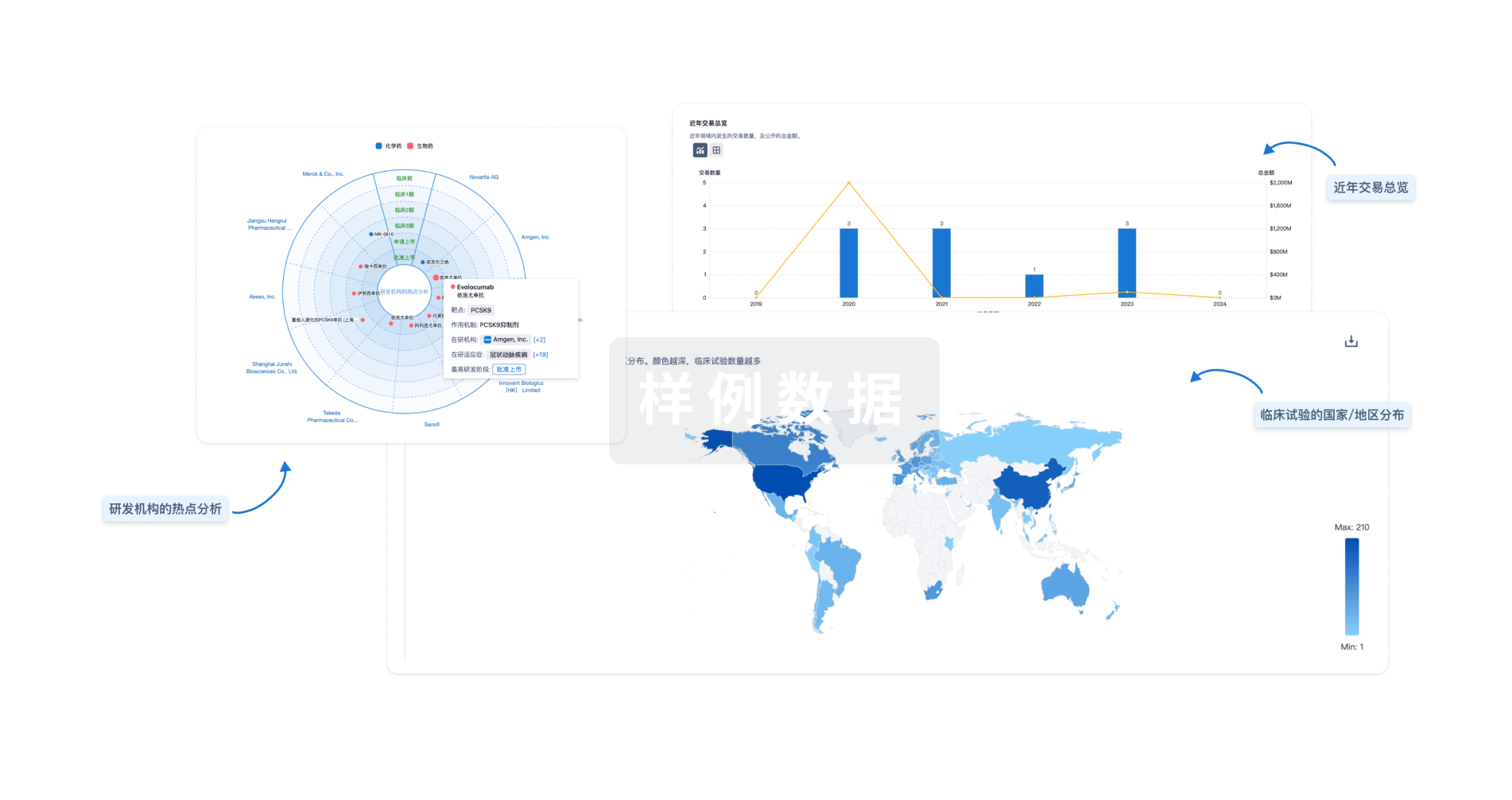预约演示
更新于:2025-05-07
IL-2Rβγ
更新于:2025-05-07
基本信息
别名- |
简介- |
关联
17
项与 IL-2Rβγ 相关的药物作用机制 FAP调节剂 [+2] |
在研适应症 |
最高研发阶段临床1/2期 |
首次获批国家/地区- |
首次获批日期1800-01-20 |
作用机制 CD28抑制剂 [+3] |
原研机构 |
非在研适应症- |
最高研发阶段临床1/2期 |
首次获批国家/地区- |
首次获批日期1800-01-20 |
作用机制 IL-2Rβγ激动剂 [+1] |
在研机构 |
原研机构 |
在研适应症 |
非在研适应症- |
最高研发阶段临床1/2期 |
首次获批国家/地区- |
首次获批日期1800-01-20 |
15
项与 IL-2Rβγ 相关的临床试验KCT0009580
Phase 2a, open-label, multi-center study of GI-101A or GI-102 (CD80-IgG4 FC-IL2v) in patients with relapsed/refractory diffuse large B-cell lymphoma following anti-CD19 chimeric antigen receptor T-cell therapy (CARNATION)
开始日期2024-07-31 |
申办/合作机构 |
NCT06470763
A First-in-human, Open-label, Multicenter Phase I/II Study to Evaluate the Safety and Anti-tumor Activity of ANV600 As Single Agent and in Combination with Pembrolizumab in Participants with Advanced Solid Tumors (EXPAND-1)
The purpose of study ANV600-001 is to characterize the safety, tolerability, pharmacokinetics (PK), pharmacodynamics, immunogenicity and antitumor activity of ANV600 administered as a single agent or in combination with pembrolizumab in adult participants with advanced solid tumors.
开始日期2024-07-01 |
申办/合作机构  Anaveon AG Anaveon AG [+1] |
NCT06277219
A Phase 1/2, Dose-Escalation and Cohort-Expansion Study to Evaluate the Safety, Tolerability, Immunogenicity, Pharmacokinetics, and Efficacy of LAT010 in Patients with Advanced Solid Tumors (LIGHTSPEED-1)
This is an open-label, multicenter, Phase 1/2, first-in-human (FIH), dose-escalation and cohort-expansion study of LAT010 to evaluate the safety, tolerability, immunogenicity, PK, PD, and antitumor activity in patients with advanced solid tumors. The study consists of 2 parts: Phase 1 dose-escalation and Phase 2 cohort expansion.
开始日期2024-06-05 |
100 项与 IL-2Rβγ 相关的临床结果
登录后查看更多信息
100 项与 IL-2Rβγ 相关的转化医学
登录后查看更多信息
0 项与 IL-2Rβγ 相关的专利(医药)
登录后查看更多信息
42
项与 IL-2Rβγ 相关的文献(医药)2025-12-31·Drug Delivery
Orchestrating T and NK cells for tumor immunotherapy via NKG2A-targeted delivery of a de novo designed IL-2Rβγ agonist
Article
作者: Yang, Hao ; Chen, Zhuo ; Lu, Xiaofeng ; Tao, Ze ; Li, Jing ; Chen, Yuzhe ; Chen, Jie ; She, Tianshan ; Zhu, Hong ; Lu, Hongyu ; Huang, Yunchuan ; Ren, Enhui
2025-03-01·Journal for ImmunoTherapy of Cancer
Novel anti-CD73-IL-2v bispecific fusion protein augments antitumor immunity by alleviating immunosuppressive adenosine pathways in CD8+T cells
Article
作者: Lee, Wonjae ; Oh, Sung-Man ; Shin, Kayoung ; Cho, Young-Gyu ; Lee, Kyungwha ; Lee, Sanghee ; Mok, Hyuckjun ; Kim, Jisoo ; Lee, Jung-Yun ; Lee, Yuseong ; Park, Suyoun ; Park, Chong Woo ; Lee, Haejong ; Kim, Jongil ; Kim, Ji-Hyun ; Lee, Eun-Jin ; Park, Min ; Kim, Kook Hwan ; Koh, Young Jun ; Park, Junsik ; Shim, Yaein Amy ; Jang, Myoung Ho ; Oh, Young Min ; Kim, Seoho
2025-01-01·International Journal of Biological Macromolecules
Novel design of potent anti-tumour activity of IL-2 prodrug by FAPα-mediated activation
Article
作者: Zhao, Wenjie ; Yao, Songjin ; Liu, Qiuyue ; Wang, Zhaofeng ; Wu, Hang ; Zhou, Xi ; Peng, Dezheng ; Liu, Yu ; Si, Linlin ; Yu, Yunzhi ; Zhu, Bo ; Zhang, Yunxiao
22
项与 IL-2Rβγ 相关的新闻(医药)2025-03-31
·药研网
3月31日,信达生物宣布,其全球首创PD-1/IL-2α-bias双特异性抗体融合蛋白IBI363已被CDE纳入突破性治疗药物(BTD)品种名单,拟定适应症为既往未经过系统性治疗的不可切除局部晚期或转移性肢端型及黏膜型黑色素瘤。近期,信达生物已启动IBI363首个关键注册临床研究并完成首例受试者给药,评估IBI363单药对比帕博利珠单抗(Keytruda®)用于治疗在既往未经过系统性治疗的不可切除局部晚期或转移性黏膜型及肢端型黑色素瘤的疗效和安全性。此前,IBI363已获美国FDA两项快速通道资格认定,分别用于治疗鳞状非小细胞肺癌和黑色素瘤。头对头K药,IBI363(PD-1/IL-2α-bias)首个关键注册临床研究完成首例受试者给药IBI363是由信达生物自主研发的全球首创PD-1/IL-2α-bias双特异性融合蛋白,同时具有阻断PD-1/PD-L1通路和激活IL-2通路两项功能。公开信息显示,IBI363的IL-2臂经过了设计改造,保留了其对IL-2 Rα的亲和力,但削弱了对IL-2Rβ和IL-2Rγ的结合能力,以此降低毒性;而PD-1结合臂可以同时实现对PD-1的阻断和IL-2的选择性递送。由于新激活的肿瘤特异性T细胞同时表达PD-1和IL-2α,这一差异性策略可以更精确和有效地实现对该T细胞亚群的靶向和激活。IBI363不仅在多种荷瘤药理学模型中展现出了良好抗肿瘤活性,在PD-1耐药和转移模型中也表现出了突出的抑瘤效力。、目前,IBI363已开出首个关键注册临床研究,用于治疗未经免疫治疗的粘膜型和肢端型黑色素瘤。此项研究(NCT06797297)是一项随机、多中心的关键临床研究,计划评估IBI363单药对比帕博利珠单抗单药在既往未经过系统性治疗的不可切除局部晚期或转移性黏膜型及肢端型黑色素瘤受试者中有效性和安全性,研究的主要终点为遵照RECIST v1.1标准,由独立影像学评审委员会(IRRC)评价的无进展生存期(PFS)。IBI363在前期研究中已在未经免疫治疗的黑色素瘤上展现出了突破性疗效信号。在两项临床试验(Ia/Ib期研究NCT05460767 和II期研究NCT06081920)中,共计纳入26例既往未经过免疫治疗的肢端型和黏膜型晚期黑色素瘤患者:总体客观缓解率(ORR)为61.5%,疾病控制率(DCR)为84.6%,对比当前国内免疫标准疗法的ORR,均有显著提升。随着随访时间延长,观察到IBI363能够给患者带来持续的肿瘤缓解,长期获益展现出优于现有标准治疗的潜力。上述两项试验前期数据已于SITC 2024发表,并将于国际学术大会更新长期随访数据。安全性方面,截至目前,全球已有几百例晚期实体瘤患者接受IBI363单药或联合治疗,总体安全性可控,常见治疗相关不良反应包括关节痛、贫血、甲状腺功能异常、皮疹,均为PD-1/PD-L1、IL-2治疗常见不良事件,临床常规治疗可控。黑色素瘤是一种从黑色素细胞发展而来的恶性肿瘤,虽然只占所有类型皮肤癌的3%,但它的死亡率是所有类型中最高的,而且最容易发生转移。PD-1/PD-L1免疫检查点抑制剂行业竞争愈发激烈,市场已趋于饱和。2024 年,默沙东的帕博利珠单抗(K药)销售额为295亿美元,再次成为全球“药王”,展现出巨大的商业价值。随着Keytruda在美国的专利将于2028年到期,更多PD-1药物涌现和发展。例如,罗氏制药的IL-2Rβγ偏向设计的PD-1/IL-2药物也在临床开发中,但其可行性仍有待验证。国内采用PD-1靶点的研发公司,如恒瑞医药和康方生物,正积极探索新的治疗策略,包括PD-1与其它靶点的联合治疗,以提升药物的市场竞争力。而IBI363需要在疗效、安全性和成本效益上展现出足够的优势,才能在市场中脱颖而出。End声明:本公众号所有发文章(包括原创及转载文章)系出于传递更多信息之目的,且注明来源和作者。本公众号欢迎分享朋友圈或大群,谢绝媒体或机构未经授权以任何形式转载至其他平台。转载/商务/投稿 | 联系微信15618157102(sum_Gmi)商务合作稿件征集点击了解详情往期回顾1关张、破产、裁员 | 2024年生物药企的阴影2全球第一款司美格鲁肽咀嚼软糖上市!3中国首个男性HPV疫苗获批上市!
突破性疗法免疫疗法临床2期ASH会议临床结果
2025-03-25
·小药说药
-01-
引言
癌症不仅是遗传变异的结果,其生存环境——肿瘤微环境(TME)的复杂性更是治疗成败的关键。其中,纤维炎症反应(Fibroinflammation)作为TME的核心特征,在肿瘤发生、转移与耐药中扮演着“双刃剑”角色。这一过程由成纤维细胞与先天免疫细胞协同驱动,通过纤维化(ECM重塑)与慢性炎症持续重塑肿瘤生态。理解纤维炎症的作用机制,或将为攻克癌症提供新突破口。
-02-
一、肿瘤细胞如何“操控”纤维炎症?
癌细胞内在致癌和肿瘤抑制途径通过驱动调节TME纤维化和炎症的异常细胞信号传导,产生了一个有利于癌细胞存活、增殖和转移的复杂生态系统。
1. 激活CAFs:肿瘤释放TGF-β、IL-6等因子,刺激邻近的癌症相关成纤维细胞(CAFs)分泌更多胶原蛋白,导致ECM硬化,形成物理屏障限制药物渗透。
2. 招募免疫“叛军”:癌细胞释放CXCL12、VEGF等趋化因子,募集并极化巨噬细胞(TAMs)、中性粒细胞(TANs),使其分泌促炎细胞因子(如IL-1β、IL-10),进一步加剧纤维炎症。
3. “恶性循环”信号轴:CAFs与TAMs通过TGF-β、IL-6等通路相互激活,形成正反馈循环,推动ECM异常沉积与免疫抑制。
-03- 二、CAFs的异质性
成纤维细胞是肿瘤微环境中最重要的细胞类型之一,它们在肿瘤的发生和发展中发挥着多重作用。成纤维细胞的异质性表现在不同的亚型上,每种亚型在肿瘤微环境中扮演着不同的角色。例如,位于肿瘤边缘的肌成纤维CAFs通过分泌LOX蛋白交联胶原,形成致密基质阻碍T细胞浸润;而肿瘤核心的iCAFs则通过IL-6等招募免疫抑制性髓系细胞,营造“冷肿瘤”微环境。
1. 肌成纤维细胞(myCAFs):这些细胞是肿瘤微环境中主要的成纤维细胞亚型,具有高度的增殖能力和产生ECM的能力。CAFs通过产生大量的胶原蛋白和其他ECM成分,促进肿瘤的生长和侵袭。此外,CAFs还能通过分泌多种细胞因子和生长因子,调节肿瘤微环境中的免疫反应。
2.炎症性成纤维细胞(iCAFs):这些细胞主要通过分泌促炎细胞因子,如IL-6和IL-1β,来调节肿瘤微环境中的免疫反应。iCAFs能够招募免疫抑制性细胞,如调节性T细胞(Tregs)和髓源性抑制细胞(MDSCs),从而抑制抗肿瘤免疫反应。
3.抗原呈递成纤维细胞(apCAFs):这些细胞具有一定的抗原呈递能力,能够激活T细胞,但它们在肿瘤微环境中通常被抑制。apCAFs的存在可能表明肿瘤微环境中存在一定的免疫活性,但这种活性往往不足以抑制肿瘤的生长。
4.肿瘤抑制性成纤维细胞:这些细胞具有抑制肿瘤生长的特性,通过产生抗炎细胞因子或抑制ECM的产生来实现。然而,这些细胞在肿瘤微环境中的具体作用仍需进一步研究。
-04-
三、纤维炎症如何“改写”肿瘤免疫状态?
纤维炎症反应与肿瘤免疫状态密切相关。一方面,纤维炎症反应通过产生大量的ECM成分,形成物理屏障,限制免疫细胞的浸润,从而抑制抗肿瘤免疫反应。另一方面,纤维炎症反应还能够通过调节免疫细胞的极化和功能,进一步抑制抗肿瘤免疫反应。纤维炎症通过以下机制将TME推向免疫抑制的深渊:
1. 物理屏障:ECM硬化形成“沙漠化”区域,阻止CD8+ T细胞浸润(免疫排斥型肿瘤)。
2. 生化压制:CAFs分泌CXCL12结合T细胞表面的CXCR4受体,将其“诱捕”在肿瘤外围;TGF-β直接抑制T细胞活性,并诱导调节性T细胞(Treg)扩增。
3. 巨噬细胞极化:CAFs通过IL-34–CCL8轴驱使巨噬细胞向M2型(促修复表型)转化,分泌IL-10、PD-L1等抑制免疫应答。
4. 血管畸形:异常ECM导致血管渗漏,加剧肿瘤缺氧,进而诱导VEGF过度分泌,形成功能失调的血管网络,进一步限制免疫细胞运输。
在胰腺癌等“冷肿瘤”中,纤维炎症主导的ECM信号与基质硬度抑制免疫活性;而“热肿瘤”(如部分黑色素瘤)虽存在T细胞浸润,但因CAFs大量表达PD-L2、FASL等,仍可能导致免疫治疗无效。-05-
四、攻克纤维炎症的破局之道
CAF在癌症发展过程中发挥的促瘤作用使其成为抗癌治疗的理想靶点。CAF导向的抗癌策略通常可分为靶向CAF的肿瘤促进功能、下游效应器和CAF激活表型的正常化。
抗CAF治疗主要集中在通过靶向特定表面标记物去除CAF,例如成纤维细胞活化蛋白(FAP)。以FAP+CAF为目标的DNA疫苗增加了CD8+和CD4+T细胞在肿瘤内的浸润。进一步的策略,如FAP-CAR-T细胞治疗和FAP靶向溶瘤腺病毒促进针对FAP+CAF的特异性免疫攻击,上调促炎细胞因子,增加抗原呈递、T细胞功能以及转运,从而增强抗肿瘤疗效。
Simlukafusp alfa(FAP-IL2v,RO6874281/RG7461)是一种免疫细胞因子,包含针对FAP的抗体和对IL-2Rβγ具有偏向性亲和力的IL-2变体。它被证明是一种有效的免疫细胞因子,在体外和体内增强了基于T细胞和NK细胞的不同癌症免疫疗法的疗效。
另一种策略是靶向CAF的下游效应器和/或信号通路,包括CAF衍生的细胞因子和趋化因子。例如,针对IL-6、IL-6R和IL-6下游JAK/STAT3信号通路的药物已被FDA批准用于骨髓增生性疾病和自身免疫性疾病,以抑制FAP+CAF诱导促炎细胞因子和促血管生成因子,它们增加癌细胞增殖和转移,并负性调节T细胞和NK细胞毒性活性。
除IL-6外,靶向TGF-β信号的治疗剂还可以干扰CAF的激活或减少CAF的数量,从而抑制肿瘤生长并具有抗肿瘤作用。Galunisertib是一种TGF-βRI激酶抑制剂,可特异性下调SMAD2的磷酸化,从而消除经典途径的激活。其已经对胶质母细胞瘤、肝细胞癌和胰腺癌患者进行了研究。
此外,靶向CAF还可以将促肿瘤性CAF的激活状态恢复为相对静止状态或肿瘤抑制表型。维生素D治疗可诱导基质重编程,使CAF活化表型正常化,抑制炎症和纤维化,提高化疗药物的摄取和胰腺星状细胞的存活率。
-06-
结语
纤维炎症反应如同一张交织的网,连接着肿瘤进展、免疫逃逸与治疗耐药。随着对CAFs异质性和动态互作的深入理解,靶向纤维炎症的策略正从“粗放型”走向“精准化”。未来,结合多组学技术、新型药物递送系统和跨学科合作,我们有望将“促癌微环境”转化为“治疗突破口”,让更多患者受益于这场癌症治疗的变革。
参考资料:
1.Cancer-associated fibroblasts andresistance to anticancer therapies: status, mechanisms, and countermeasures. CancerCell Int. 2022; 22: 166.
2. The fibroinflammatory response in cancer. Nat Rev Cancer.2025 Mar 17.
公众号内回复“ADC”或扫描下方图片中的二维码免费下载《抗体偶联药物:从基础到临床》的PDF格式电子书!
公众号已建立“小药说药专业交流群”微信行业交流群以及读者交流群,扫描下方小编二维码加入,入行业群请主动告知姓名、工作单位和职务。
免疫疗法临床研究
2025-03-03
·药研网
2025年3月3日,信达生物宣布,其全球首创PD-1/IL-2α-bias双特异性抗体融合蛋白IBI363单药治疗对比帕博利珠单抗(Keytruda®)的关键注册研究完成首例受试者给药,用于治疗在既往未经过系统性治疗的不可切除局部晚期或转移性黏膜型及肢端型黑色素瘤。
这是IBI363的首个关键注册临床研究,也标志着中国自主研发的创新肿瘤免疫(IO)疗法向攻克"冷肿瘤"全球治疗难题迈出关键一步。
IBI363是由信达生物自主研发的全球首创PD-1/IL-2α-bias双特异性融合蛋白,同时具有阻断PD-1/PD-L1通路和激活IL-2通路两项功能。
公开信息显示,IBI363的IL-2臂经过了设计改造,保留了其对IL-2 Rα的亲和力,但削弱了对IL-2Rβ和IL-2Rγ的结合能力,以此降低毒性;而PD-1结合臂可以同时实现对PD-1的阻断和IL-2的选择性递送。由于新激活的肿瘤特异性T细胞同时表达PD-1和IL-2α,这一差异性策略可以更精确和有效地实现对该T细胞亚群的靶向和激活。IBI363不仅在多种荷瘤药理学模型中展现出了良好抗肿瘤活性,在PD-1耐药和转移模型中也表现出了突出的抑瘤效力。
此前(2月17日),信达生物宣布,IBI363 (PD-1/IL-2α-bias双特异性抗体融合蛋白) 获美国FDA快速通道资格认定,拟定适应症为抗PD-(L)1免疫检查点抑制剂及含铂化疗治疗后进展的局部晚期或转移性鳞状非小细胞肺癌.
目前,IBI363已开出首个关键注册临床研究,用于治疗未经免疫治疗的粘膜型和肢端型黑色素瘤。此前(2月17日),信达生物宣布,IBI363 (PD-1/IL-2α-bias双特异性抗体融合蛋白) 获美国FDA快速通道资格认定,拟定适应症为抗PD-(L)1免疫检查点抑制剂及含铂化疗治疗后进展的局部晚期或转移性鳞状非小细胞肺癌。
此项研究(NCT06797297)是一项随机、多中心的关键临床研究,计划评估IBI363单药对比帕博利珠单抗单药在既往未经过系统性治疗的不可切除局部晚期或转移性黏膜型及肢端型黑色素瘤受试者中有效性和安全性,研究的主要终点为遵照RECIST v1.1标准,由独立影像学评审委员会(IRRC)评价的无进展生存期(PFS)。
IBI363在前期研究中已在未经免疫治疗的黑色素瘤上展现出了突破性疗效信号。在两项临床试验(Ia/Ib期研究NCT05460767 和II期研究NCT06081920)中,共计纳入26例既往未经过免疫治疗的肢端型和黏膜型晚期黑色素瘤患者:
总体客观缓解率(ORR)为61.5%,疾病控制率(DCR)为84.6%,对比当前国内免疫标准疗法的ORR,均有显著提升。
随着随访时间延长,观察到IBI363能够给患者带来持续的肿瘤缓解,长期获益展现出优于现有标准治疗的潜力。
上述两项试验前期数据已于SITC 2024发表,并将于国际学术大会更新长期随访数据。
安全性方面,截至目前,全球已有几百例晚期实体瘤患者接受IBI363单药或联合治疗,总体安全性可控,常见治疗相关不良反应包括关节痛、贫血、甲状腺功能异常、皮疹,均为PD-1/PD-L1、IL-2治疗常见不良事件,临床常规治疗可控。
黑色素瘤是一种从黑色素细胞发展而来的恶性肿瘤,虽然只占所有类型皮肤癌的3%,但它的死亡率是所有类型中最高的,而且最容易发生转移。
本项研究的主要研究者、北京大学肿瘤医院郭军教授表示:"在中国,黑色素瘤病死率高,发病率也在逐年增加。既往未接受免疫治疗的黑色素瘤患者PFS仅3个月左右,存在较大未满足的临床需求;且我国占比较大的非皮肤型黑色素瘤(尤其是黏膜型)是对免疫治疗不敏感的"冷肿瘤",如同免疫治疗荒漠,临床获益更加有限,亟待更加有效的治疗手段。而IBI363通过PD-1与IL-2的双重激活,将'冷肿瘤'转化为'热肿瘤',早期数据已展现治愈曙光,在Ia/Ib期和II期研究中已展现出令人鼓舞的疗效和良好的耐受性,有望成为针对恶性黑色素瘤的新型免疫疗法。我将与其他研究者们齐心协力推进完成此项关键临床研究,稳扎稳打获得高质量临床数据,为肢端型和黏膜型恶性黑素瘤患者提供更为有效的治疗选择。"
PD-1/PD-L1免疫检查点抑制剂行业竞争愈发激烈,市场已趋于饱和。2024 年,默沙东的帕博利珠单抗(K药)销售额为295亿美元,再次成为全球“药王”,展现出巨大的商业价值。随着Keytruda在美国的专利将于2028年到期,更多PD-1药物涌现和发展。
例如,罗氏制药的IL-2Rβγ偏向设计的PD-1/IL-2药物也在临床开发中,但其可行性仍有待验证。国内采用PD-1靶点的研发公司,如恒瑞医药和康方生物,正积极探索新的治疗策略,包括PD-1与其它靶点的联合治疗,以提升药物的市场竞争力。而IBI363需要在疗效、安全性和成本效益上展现出足够的优势,才能在市场中脱颖而出。
End
声明:本公众号所有发文章(包括原创及转载文章)系出于传递更多信息之目的,且注明来源和作者。本公众号欢迎分享朋友圈或大群,谢绝媒体或机构未经授权以任何形式转载至其他平台。
转载/商务/投稿 | 联系微信15618157102(sum_Gmi)
商务合作
稿件征集
点击了解详情
往期回顾
1
12月 | 16家生物医药裁员汇总
2
全球第一款司美格鲁肽咀嚼软糖上市!
3
中国首个男性HPV疫苗获批上市!
免疫疗法临床结果临床2期
分析
对领域进行一次全面的分析。
登录
或

生物医药百科问答
全新生物医药AI Agent 覆盖科研全链路,让突破性发现快人一步
立即开始免费试用!
智慧芽新药情报库是智慧芽专为生命科学人士构建的基于AI的创新药情报平台,助您全方位提升您的研发与决策效率。
立即开始数据试用!
智慧芽新药库数据也通过智慧芽数据服务平台,以API或者数据包形式对外开放,助您更加充分利用智慧芽新药情报信息。
生物序列数据库
生物药研发创新
免费使用
化学结构数据库
小分子化药研发创新
免费使用


